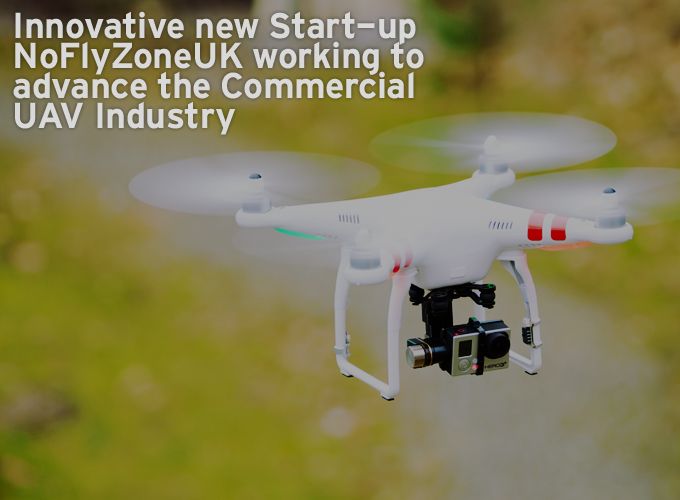Recent debates have brought a range of UAV driven privacy concerns to light, with key fears including trespassing, nuisance and data protection.
Contributed by | NoFlyZoneUK
With increased usage of UAVs taking place over the course of the last 12 months concerns over privacy, safety and airspace access have come to the forefront of industry debates. Regulatory processes are continuing to evolve in the face of this expanding industry to ensure that such concerns are all addressed correctly. However the challenge is effectively tackling these issues without hindering the UAV industry and the vast benefits it can bring. In light of such debates SkyTech sat down with John Tansley, Managing Director of NoFlyZoneUK, a completely free service set-up to ensure that privacy and safety concerns are addressed without inhibiting the development of the UAV industry.
Can you tell us a little bit about NoFlyZoneUK?
‘Currently, our main function is to act as a mapping resource for the UAV Industry enabling operators to keep up-to-date with NoFlyZone requests made by the public. The data is 'real-time' meaning that it is constantly being updated/amended as and when requests come in/withdrawn. It also allows for updates in Air Traffic Management where, for example, temporary obstacles could cause issues for UAV flights. Although the industry is still very much in development, we wanted to start addressing potential problems in relation to flight management & privacy before they become an issue’.
The UAV industry has experienced huge growth over the last few years, with many industries now considering the technology an integral part of their day-to-day activities.
What is the vision behind NoFlyZoneUK?
‘Our aim, is to be able to provide a fully-functioning Air Traffic Management system for all UAV operators. Particularly also for when beyond-the-line-of-sight flights become a reality. We also aim to be the conduit between the public and UAV operators in relation to sharing information about flight sorties. We envisage building a real-time traffic display system that will enable people to know which operator is flying and to where. We feel that this sharing of information will be vital to the progression of the industry’.
NoFlyZoneUK addresses a number of challenges currently faced by the UAV industry.
Can you tell us more about the services you offer?
‘Currently, we offer free access to our No Fly Zone Mapping system via our website at NoFlyZoneUK.org. We also offer a database of Air Access points for when drone deliveries become available. We will maintain a central real-time database that will allow UAV delivery companies to be able to identify preferred drop-off points for items which are to be delivered by drone. This will prevent the need for people to keep updating several different companies as to where they would prefer their Air Access point to be. We are also looking to develop a 'counter-UAV' intercept service that will prevent potentially harmful UAVs being used for illicit purposes from achieving their operator-defined objectives. We will use our extensive experience from working within the public security services in order to help protect the public and reputable UAV operators’.
Recent debates have brought a range of UAV driven privacy concerns to light, with key fears including trespassing, nuisance and data protection.
What privacy concerns have you found to be most prevalent in the UAV industry?
‘Most of the people with whom we speak, state that their main concerns evolve around UAV's potentially getting data about them, whether photographic or otherwise, and then sharing this data with third parties. There has also been quite a bit of concern cited in relation to UAVs being used by, for example, criminals to gather intelligence about a potential burglary target (such as access points), as well as being used for terrorist purposes. This is why we feel that it is essential to be able to provide a live 24-7 Air Traffic Management and display service, so that people can be certain that if they spot a UAV in the sky and cross reference their position with our real-time tracking, then they will have nothing to worry about, as the UAV will be registered and tracked and its position monitored’.
Privacy is just one of a number of concerns dominating the UAV industry at present, what other concerns have you found the public has surrounding the use of UAVs?
‘Other than privacy, there seems to be quite a bit of concern surrounding the scenarios whereby UAVs suffer a malfunction and fall out of the sky. Much of this concern can be addressed by educating the public, and indeed, when we get asked such questions, we always go into great detail regarding the various fail-safe redundancies which are being built into both existing and developing systems. The image of a UAV falling from the sky onto someone’s head is one that is often cited by mainstream media as being the real concern behind UAV flights’.
There is a belief amongst some in the industry that having No-Fly-Zones are anti the UAV industry. How does NoFlyZoneUK aid UAV operators?
‘We aid the industry, by providing solutions to potential issues before they occur. By adopting this pre-emptive approach, we hope that the sector will grow and the true benefits of the industry will be felt by everyone whilst at the same time addressing genuine security and privacy concerns. Currently, we achieve this by our free-to-use No Fly Zone database, but in the future we hope to be able to provide the infrastructure necessary in order for the technology to flourish’.
With the UAV industry still in its infancy the sector is set to see much evolution in the coming years. What direction do you see the industry taking?
‘I think that, for the moment at least, photography/filming UAV applications will continue to dominate the sector, as well as aerial surveying work. However, once Amazon and companies like Alibaba, Google, who are developing their own UAV delivery service called 'Google Wing', prove their systems to the relevant authorities, then beyond the line of sight flights will start to be approved which will then herald a new dawn in the way, not only the public, but the emergency services, security companies, utility companies and the like go about their business. I also fear, that at some point, a UAV will be used for 'lone-wolf' mass-casualty purposes, which is why it is vital to put into place now the measures needed to keep a track of all UAV flights, and to put into place an efficient and dynamic counter UAV infrastructure. I was on shift, as a Police Officer, in the Tower Hamlets Borough dedicated anti-terrorism vehicle when the suicide bombers hit the underground system on the morning of 7/7 so I am acutely aware of what those intent on mass casualty situations can achieve. One only has to look around the globe, in Paris and Japan as two examples, of what can happen when ill-minded individuals get hold of UAVs. A terrorist incident on these shores will set the industry back at least 5 years. I have previously met with the DfT and discussed our plans with Paul Cremin who heads-up the Governments approach to RPAS system, and I hope that we can continue to work together, as well as with the wider industry as a whole, to grow the sector whilst at the same time maintaining its security and integrity. We have also been in contact with the CAA & MOD in relation to our plans. Notwithstanding the above, I foresee that in 3-5 years, UAVs will be deployed in all manner of scenarios, from delivering groceries, to taking over from Police Helicopters. The will of the industry, as well as proven concepts of deployment, will change the manner in which we live our daily lives’.
With UAV technology continually advancing, what are the next steps for NoFlyZoneUK?
‘For now, we shall continue to promote our mapping and Air Access services to both the public, UAV industry and various Government stakeholders whilst seeking out partners and investors whom can support our current and future activities. The UAV sector is one that I am very passionate about. Emerging technologies which have the scope to change our lives only come along once every 10-15 years, so for me, it is an honour and a privilege to be involved in one such as UAVs’.
For more information about NoFlyZoneUK visit their website http://www.noflyzoneuk.org/ or for more details about the UAV industry visit SkyTech 2016 UAV Conference & Expo taking place on the 27th & 28th January 2016.
The content & opinions in this article are the author’s and do not necessarily represent the views of RoboticsTomorrow
Featured Product



